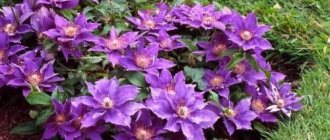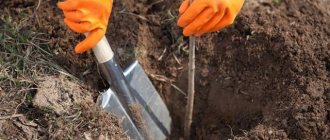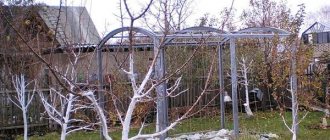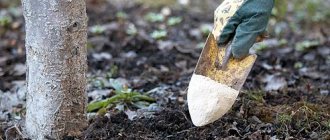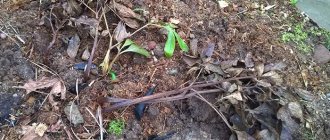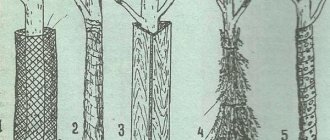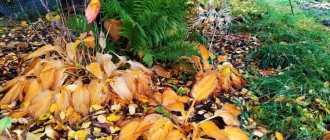How to insulate lavender in different regions of Russia
The insulation of a bush depends on the climate in which it grows. So:
- In the Moscow region and the middle zone, where winter is quite warm and there is little snow, but there are sharp temperature changes, mulch the bushes with peat, straw or hay, and if necessary, additionally cover them with non-woven material. Cover the ground carefully, since melt water saturates the ground during thaws, and subsequent frosts lead to freezing of the roots.
- Lavender in Krasnodar, Stavropol, Kuban and other southern regions does not need to be covered, but only the tree trunk circles under it can be mulched; peat or straw is suitable for this. Tie the branches with twine so that strong winds do not break them.
- In the north of Russia, in the Volga region, Siberia, and the Urals, where the temperature often drops below -35°C, insulate the lavender with lutrasil, jute material, geotextile or agrofibre, and on top of any of these materials place a “hut” of spruce or pine branches - they They retain heat well, but allow air to reach the crops. This is why polyethylene is not suitable for covering - perennials begin to rot under it. In addition, you need to plant the right variety, for example, Tenderness or Purple Spike.
Autumn pruning
An important and responsible moment is autumn pruning. The procedure helps preserve the decorative appearance of the bush and prepares the plant for wintering. Lavender has a taproot that goes deep into the soil. Therefore, many varieties can withstand frost. Spring temperature changes are terrible for the plant. The snow thaws and freezes again, creating a dense ice crust. The access of oxygen is limited, the bushes die.
They form bushes in the second year of life.
Work algorithm:
- Sharp garden shears or pruning shears are treated with alcohol. This is important, otherwise the instrument will become infected.
- They inspect the bush and, first of all, free it from diseased, dry, broken branches.
- Lavender stems are woody at the bottom and green at the top. Pruning is carried out 3 centimeters above the lignified part. Completely lignified shoots are not touched.
- The procedure is carried out after re-flowering. If the plant has not had time to bloom, young shoots are not pruned.
- The second case: they were late with pruning before the onset of cold weather. Plants may not have time to prepare for winter. Therefore, the shoots are not touched until spring. They are tied, bent to the ground, covered with spruce branches.
See also
Rules for growing and caring for rhododendron at homeRead
In the Moscow region, the onset of autumn cold may be delayed or come unexpectedly. All actions are associated with climatic conditions in a particular season .
Time and method
During the growing season, lavender needs pruning.
Spring
In early spring, remove the cover from the lavender. Carry out sanitary pruning. Remove frozen, rotten, dried shoots. If, for some reason, the formation of a bush was not carried out in the fall, this is corrected in the spring, according to the same principle as in the fall.
Summer
The first flowering ends in mid-August. To improve decorativeness and stimulate the growth of new shoots, remove wilted inflorescences with a pair of leaves.
Autumn
The second flowering ends in early October. Gardeners immediately begin preparations for wintering so that the plant has time to adapt before the onset of cold weather.
Anti-aging pruning of old specimens is also carried out in the autumn. In the first year, the outer contour of the bushes is cut off, the central shoots are left. After a year, the outer branches are left, the central branches are removed 10-15 centimeters from the base.
Do I need to feed the plant after this?
In order for the plant to overwinter well, pruning, fertilizing, and covering are carried out in the fall. The bush is watered abundantly. As soon as the water is absorbed into the soil, the soil is loosened.
For feeding, buy mineral complex fertilizers at the flower shop. Add 2 tablespoons of the drug to a bucket of water. The solution is poured around the perimeter of the bush.
Common mistakes when preparing lavender for winter
Lavender may die if:
- water it generously in the fall;
- feed the bushes with nitrogen fertilizers;
- cut the crop incorrectly (too long or too short);
- cut lavender in late autumn - the perennial will not have time to heal its wounds and recover;
- in the spring, open it too early or remove the mulch.
Avoid these mistakes, and your beautiful lavender will bloom and smell fragrant all summer long!
Author of the article: Natalya Racine
Typical care mistakes
Typical mistakes encountered in the process of growing lavender:
- They trim the shoots to the roots, considering that this is a herbaceous plant, and the same methods are chosen. Only green shoots are trimmed.
- Lavender is poured. Due to excess moisture, the root rots and the bush dies.
- Choose an airtight covering material, for example, polyethylene. The ground part becomes warm, which leads to fungal infections.
- Inexperienced gardeners, without waiting for the lavender to grow, pull it out. This is a type of plant with late awakening. There is no point in getting rid of bushes ahead of time.
- Wrong soil. The flower loves breathable soil with an acidic reaction.
If the bush is not pruned in the fall, then it is tied up. Snow will not be able to get into the central part of the flowers and thereby damage them by freezing. The plant in a bunch will warm up better.
Annual and perennial lavender
There is annual and perennial lavender. An annual plant will not overwinter in our conditions: you need to collect ripe seeds and plant them in open ground the next year. And so - from year to year.
I have annual lavender. And although I don’t like to mess around with annuals, I plant lavender every year. The bushes grow quickly, in beautiful, lush clumps that exude a divine aroma. During the summer I cut all the flowers and dry them. When autumn comes, I collect seeds and sow them for next year. I try to renew the seeds every year so that there is always a fresh batch. I make a fragrant sachet from dried flowers or simply tie bouquets and put them on the shelf. Tested: the scent lasts for more than three years!
Photo: The easiest and fastest way is to buy lavender seeds.
Perennial varieties will delight you for many years. But in order to preserve them in winter, you need to properly prepare the bushes in the fall. If perennial lavender is left to grow on its own, one day you will find that the bush has stopped developing after the cold weather and died.
The easiest and cheapest way to get a lavender bush for your plot is to buy seeds or get them from friends.
It is very easy to grow both annual and perennial lavender from seeds. They are sold in many garden departments. From my experience I will say that it is easy to grow; the main condition for successful cultivation is proper care of the plant throughout the season.
A more expensive method is to plant a bush already grown in a pot, purchased from a nursery or store.
Frost-resistant type of lavender and its varieties
Lavender is a heat-loving plant that came to us from the southern regions. There are about 20 plant species. Of these, only one is frost-resistant - angustifolia lavender (English). It can be safely planted in Siberia and Central Russia. Under thick snow, the bush can withstand even severe frost - 35 degrees.
Frost-resistant varieties have been bred from this species, which are recommended for planting in the Siberian region and for the center of Russia:
Lavandin
Forms a fragrant, lush bush. Do not plant many of these bushes at once: the strong smell can provoke an allergic reaction and cough.
Photo: Variety Lavandin.
Beachwood
It is considered the most cold-resistant of all varieties. The flowers are bluish, with a pleasant aroma.
Photo: Beechwood variety.
Normandy.
Annual variety. This is exactly what I talked about above. It grows up to 50 cm in height. It quickly grows green mass. Seeds are planted immediately in a permanent place, without growing seedlings.
Photo: Variety Normandy.
Hidcote
The curtain spreads over an area of about a meter. During the season, a lot of fresh, green growth grows. The flowers are purple. Flowering continues all summer.
Photo: Hidcote variety.
Judith
A dense spherical bush will grow up to 50 cm upward. The flowers are violet-blue. Both flowers and leaves emit a very strong and pleasant aroma.
Photo: Variety Judith.
| Advice. Do not plant lavender in lowlands and wetlands, it will die there. Think of the fields of Provence - dry, open spaces that often experience periods without rain. Whether the lavender will successfully overwinter depends on the correct choice of place when planting. It may not die from frost in the lowlands, but from stagnant moisture it will definitely get wet and rot. |
Covering lavender for the winter
Some people believe that lavender overwinters very poorly and is highly susceptible to freezing. They even recommend pruning lavender in the spring because... autumn pruning can cause the bush to freeze (although if you do not prune it in the fall, the branches may simply break off under the weight of the snow). However, this opinion is somewhat erroneous.
Interesting! Lavender is more likely to get wet in the spring (after the snow melts) than to freeze. Therefore, under no circumstances should it be planted in lowlands or wetlands.
Lavender is a fairly frost-resistant plant (withstands frosts down to -25 degrees), thanks to its deep (tap) root system.
However, in young bushes the root system has not yet developed, which means they can actually freeze out. That's why they need additional shelter for the winter.
Thus, lavender is usually not covered for the winter, especially in warm countries, but in cooler regions some insulation is required, but only for young bushes (recently planted).
By the way! The site has an article on how to properly plant and grow lavender .
How to cover lavender for the winter, what to mulch with
Suitable mulch for lavender is compost, humus (which will also be a long-lasting fertilizer), straw, and rotted sawdust.
Just take it and pour it under the bushes, moving the branches aside.
Only the trunk circle should be mulched: the trunk itself should not be covered with mulch, otherwise the plant may rot.
If you have very severe frosts and little snow, then it is advisable not only to mulch, but also to cover the lavender for the winter with non-woven material (the same spunbond, lutrasil) or spruce branches, especially in the first year, when the bushes have not yet grown deep roots.
If your winters are snowy, then a layer of mulch will be enough; in extreme cases, you can use snow. Yes, snow is the best covering material. Just sprinkle the bush with snow and that’s it.
Interesting! English lavender (better known as narrow-leaved) is quite frost-resistant, which cannot be said about its French (broad-leaved) variety, which is preferably grown in a pot and taken to an insulated loggia or windowsill for the winter.
Indeed, many gardeners are afraid to leave lavender to overwinter in the open ground during the first winter, so they dig it up, replant it in pots and bring it into the house.
Breeding culture
The easiest way to propagate lavender is to divide an already mature bush. To do this, at the beginning of summer, the bushes are covered with earth so that more roots can form on the stems. In September or October, the bushes are dug up and carefully divided into several parts with a shovel, which are then transplanted to the desired location. This lavender will bloom next year.
Another effective method is layering. The oldest shoot is pinned to the ground with a metal spike, soil is placed on top, but the top remains free. Roots grow on the part sprinkled with soil, after which the shoot is cut off and planted in a new place. You need to care for it in the same way as an adult bush.
Propagation by cuttings allows you to get new bushes at any time of the year. To do this you need to do the following:
- Cut off woody branches from an adult bush.
- Place universal soil for seedlings in tall pots, which you first water with warm water.
- Stick the cuttings into the soil.
- The pots need to be covered with film to maintain high humidity underneath.
- Air the pots daily and spray the soil when it dries.
- After one to two months, each shoot will sprout roots and leaves.
After this, in spring or autumn, new bushes can be planted in open ground.
Why you need to prune lavender
Being a perennial plant, lavender needs regular pruning.
The stems of its overgrown bushes thicken and become hard over time, and flowering ceases to be abundant. The decorative value of untrimmed bushes, which have lost their attractive compact shape, is significantly reduced. To minimize the stress caused by pruning, lavender bushes are pruned partially in the spring and partially in the fall. Spring pruning , which consists of removing damaged, dry and frozen shoots, is mainly of a sanitary nature.
Autumn pruning is performed:
- In order to help the heat-loving crop survive the winter without much loss. In regions with little snowy winters, long shoots must be shortened, since with a sharp drop in temperature there is a high probability of them freezing. In addition, frozen branches become extremely fragile, unable to withstand the effects of strong cold winds. Broken branches can subsequently be attacked by insect pests or become a breeding ground for bacterial or viral infections.
- In order for the lavender bushes to continue to remain compact for a long time. However, not all gardeners resort to severe pruning of the green part of the shoots. Some of them prefer to maintain the maximum possible length of branches, leaving the shape of the crown unchanged. They proceed from the belief that practically untouched bushes are completely buried under the snow and, being warm, do not freeze at all.
Features of caring for lavender in the fall and preparing for winter: what to do with the shrub after flowering
Recommended measures for caring for lavender in the fall and in preparation for winter usually include the following:
- loosening the tree trunk circle of shrubs and weeding (removing weeds);
However, rarely does anyone grow lavender without mulch, and mulching eliminates loosening and weeding.
- feeding;
- pruning, or more precisely, haircut ;
The pruning procedure is not mandatory, i.e. carried out at the request of the gardener. In other words, whoever wants, trims (shapes) as he wants. But there are still a few recommendations.
- shelter for the winter (mulching).
By the way! In the fall, you can cut lavender branches for vegetative propagation .
How to care for a plant
Loamy or sandy loam soils with a fertility level above average are considered the most suitable (you can enrich the soil with mineral additives with a high concentration of nitrogen). There are also rules for soil care. After heavy watering or rainfall, surface loosening is necessary. The soil under lavender should under no circumstances harden, in which case the roots' access to oxygen will noticeably deteriorate.
You need to mulch the garden bed using organic humus or peat. Lavender, although demanding on the level of soil moisture, does not require frequent watering and is considered a drought-resistant species. Watering should occur as needed: once every four days or a week, check the moisture content of the soil around the stem. Excessive watering can be determined by clear external signs - lavender leaves turn yellow, and the growth of vegetative parts slows down or almost completely stops.
At the beginning of each season, fertilizers need to be applied to the soil. Nitrogen fertilizers are considered the most optimal, stimulating the growth of green mass and strengthening lavender before flowering. In autumn, nitrogen complexes cannot be used: the plant will not have time to adapt to the cold. During the period of bud blooming, you need to give lavender mineral fertilizers. If there are fresh layers of mulch on the soil, you don’t have to fertilize at all.
Lavender pruning occurs twice a calendar year. Summer should occur in July, when the first flowering ends and seeds begin to set. This encourages the plant to form new buds, which will bloom in 2-3 weeks. The second is organized in the spring, after frost. It allows you to accelerate the formation of new green mass. Also, at the beginning of the season, for aesthetic purposes, you can shorten the lavender branches, but not more than by a third.
Lavender can withstand the first autumn frosts. And the maximum level of cold in which the plant survives is -25 degrees Celsius. To ensure careful care and preserve lavender during the winter months, you need to cover it from snow, and it is best to use materials of natural origin. Fallen leaves are well suited, as they gradually rot and rot, turning into natural fertilizer.
Every November it is worth trimming the lavender to the woody part. This way the plant will be better preserved until the next season and will grow faster, which means it will bloom faster.
What species can be grown in the Moscow region
There are about 45 varieties of lavender, which can be grouped into three types. English lavender has become most widespread in the Moscow region, as it is resistant to survival in open ground in the middle zone in winter.
A characteristic external feature of narrow-leaved English lavender is elongated inflorescences with a uniform color, as well as narrow, neatly shaped leaves. The shrub fits well into alpine lawns. The varieties of the English category include:
- Hidcote;
- Voznesenskaya;
- Blue space;
- Southerner;
- Delight;
- Dwarf Blue;
- Purple Haze.
Spanish lavender is rarely chosen by ordinary gardeners. The fact is that this group of lavender varieties has a characteristic and bright smell and is often used in the creation of perfume products. However, the rich lilac or violet color of Spanish lavender gives it a chance to appear in garden beds. Is it possible to grow in the Moscow region? It is better not to take risks, since the plant is heat-loving, needs constant care, natural light and does not winter well. The following varieties belong to the Spanish category of lavender:
- Ballerina;
- Van Gogh;
- Pappillion;
- Tiara;
- Preeti Polly;
- Petit Raf;
- Fathead;
- Regal Splendor.
The aroma of French lavender is more calm. But it attracts attention thanks to the beautiful shape of the flowers. The leaves of French lavender are wider than those of the English group, which harmonizes well with the small and aesthetic buds. In the Moscow region it is quite difficult to grow such flowers, since temperature fluctuations and the peculiarities of the local winter can destroy all plantings. But in indoor conditions it will take root well. French varieties are considered:
- Rocky Road;
- Yellow Vale;
- Snowman;
- Snow Bunny (the names refer to the delicate white colors characteristic of many representatives of the French branch).
Lavender pests: how to protect the plant
Due to the high concentration of essential oils in the tissues of the plant, it is rarely attacked by insects and pathogenic bacteria. The most common disease of lavender can be called gray rot. It occurs due to incorrect watering and maintenance patterns, which is why it is worth focusing on proper soil moisture. The disease cannot be cured. Therefore, promptly remove infected shrubs from the beds and burn them.
Occasionally, lavender can be attacked by leaf beetles (rainbow beetles, chafer beetles and other representatives of beetles), spider mites, and cicadas. All of them can harm not only lavender, but also neighboring plantings and even full-fledged trees. But pests rarely attack lavender. Those that appear on the sheets are so few in number that they can easily be collected by hand. Plants can be protected by treating them with insecticides before planting. During the flowering period, the plants are completely safe.
{SOURCE}
